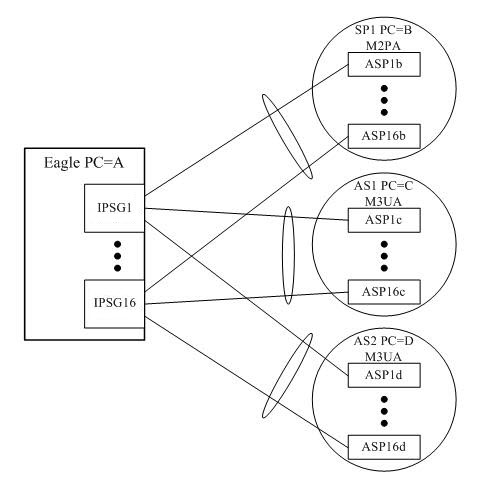A Additional Deployment Scenarios
This chapter provides additional scenarios for deployment of SS7-over-IP using SIGTRAN.
IPSG Deployment Scenario
Figure A-1 Example Deployment of IPSG Application

Note:
- Oracle Communications EAGLE Service and Link Interface Card (SLIC) is a single-slot, multi-use card that runs multiple applications.
- Each IP-attached signaling point or application server is represented in EAGLE as a linkset (ovals).
- Up to 16 IPSG links are supported per linkset
- If an E5-ENET-B card is used as the IPSG card, and if the E5-ENET-B IPSG High Throughput feature is turned ON, then the card supports a maximum of 4 links before de-rating. See Factors Affecting Advertised Capacity for additional information.
- Each connecting line represents an SS7 signaling link and an SCTP association.
- Multiple linksets are supported.
- Each linkset supports one SIGTRAN adapter type (M2PA or M3UA).
- Point Codes ‘B’, ‘C’, and ‘D’ can involve any mixture of ANSI and ITU point codes. If different variants are in use, Eagle must have a point code in each of the networks.
- Multiple signaling links per card are supported.
The IPSG feature provides the M3UA functionality that behaves more like other LIMs,
providing the following benefits:
- The new IPSG application M3UA operational model equates Linkset (LS) and Application Server (AS). It equates Signaling Link (SLK) with an AS-ASP (Routing Context + Association) instance. This allows each AS-ASP instance to be administered as a signaling link.
- A new signaling link type, IPSG-M3UA, can be assigned to linksets having up to 16 signaling links. This is double the 8-link (and card) limitation of the former IPGWx linkset.
- Each IPSG card will host up to 128 signaling links.
- Each IPSG card will host up to 128 SCTP associations. A maximum of 16 IPSG-M3UA signaling links can be assigned to a single association.
- The adjacent point code (APC) of the IPSG-M3UA linkset is the point code assigned to the Application Server serviced by the linkset. The IPSG-M3UA linkset does not require a fake adjacent point code as the former IPGWx application does.
- Each IPSG-M3UA signaling link can have a single IP connection, unlike the former IPGWx signaling link, which can have up to 50 IP connections.
- The state of the IPSG-M3UA signaling link is based on the states of the assigned IP connection and AS-ASP instance. If the IP connection is unavailable for traffic, the IPSG-M3UA signaling link is also unavailable. If the AS-ASP instance is not available, then the IPSG-M3UA signaling link is also unavailable. *
- Multiple IPSG-M3UA signaling links (up to 16) can share one IP connection, as long as all of the IPSG-M3UA signaling links and corresponding IP connection are hosted by the same card. This enables multiple SS7 variant support across a single IP connection.
- The IPSG-M3UA signaling links provide MTP3 routing only. The IPSG application does not implement secondary routing-key routing, so every attached AS must be uniquely identified in the network by a point code.